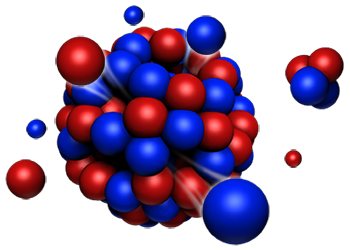Speaker
Description
Structure determination of materials on the atomic scale requires diffraction techniques and accurate structure is essential in order to understand physical properties. Neutron diffraction is complementary to X-ray diffraction but relies on large-scale neutron facilities, of which there are relatively few cf. X-ray sources, and the favourable properties of the neutron for material investigations: high penetration depth, light element sensitivity, isotope dependent scattering, low energy and magnetic interaction.
For powder diffraction, there are two types of neutron powder diffractometer (NPD), monochromatic and time-of-flight (TOF). The former uses a narrow wavelength band, selected by a monochromator, and either scan a set of point detectors over the scattering angle (D2B [1] type) or employ wide-angle area detectors (D20 [2] type) to obtain diffraction data. TOF diffractometers use a wavelength band, defined by the total instrument length, available time-window and moderator characteristics (related to the duty cycle of the source and/or chopper frequency), and fixed angle detector banks, e.g. Polaris [3].
Reactor neutron sources pioneered the development and use of monochromatic NPDs and pulsed spallation neutron sources established the TOF method. The design of NPDs follows the general premise: continuous sources build monochromatic instruments, except where significantly restricted geometry constraints are present, where TOF methods are preferred or necessary, and pulsed sources build TOF instruments. Most research reactors are ageing and several have closed in the last 12 months. The majority of the current world class and next generation large-scale facilities in Europe and beyond are spallation sources.
While science cases for monochromatic NPDs are well established, what impact will large-scale facility type have on future NPDs? If reactor sources have seen their heyday, what will become of the monochromatic NPD? Are there possibilities for next generation NPDs other than TOF instruments at current and future pulsed spallation sources? Instrument design, construction and operation must always be science case driven. Are there science cases that remain better addressed with monochromatic NPDs? How will the landscape change with source closures over the next 10-15 years with respect to capacity and capability for the user community? Here I will describe some possibilities that need investigation and evaluation while expertise is available at operational reactor sources.
[1] E. Suard, A.W. Hewat. Neutron News 2001, 12, 20-25.
[2] T.C. Hansen, P.F. Henry, H.E. Fischer, J. Torregrossa, P. Convert. Meas. Sci. Technol. 2008, 19(3), 034001.
[3] R.I. Smith, S. Hull, M.G. Tucker, H.Y. Playford, D.J. McPhail, S.P. Waller, S.T. Norberg, Rev. Sci. Instrum., (accepted).

